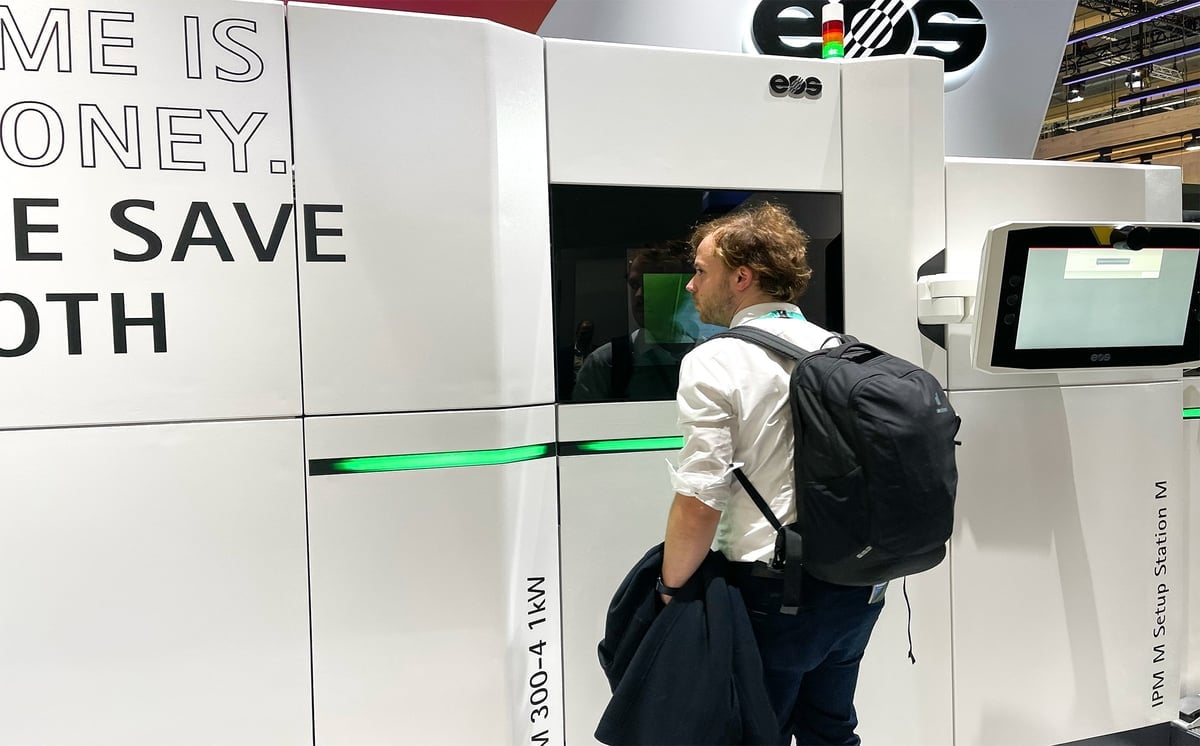Metal 3D printing is more accessible than ever from a broadening market of machine makers. The technology has proven itself in rocket engines and replacement parts, as well as in industries ranging from automotive and defense to medical and light manufacturing.
Not only can you create parts with shapes and internal structures not possible with metal injection molding, casting, or machining, but metal 3D printing is a faster and cheaper (at low- to mid-volume) solution, making it possible to deliver metal parts in hours or days, not weeks.
We’re also seeing the technology used to fabricate unique metal injection molds and tools now vastly more affordably. Mission-critical repair parts for the oil & gas and energy sectors are preventing outages and keeping supply chains moving.
To top it off, metal 3D printing has a host of other benefits over traditional manufacturing, such as the ability to easily outsource for local production to service providers worldwide, along with less waste and a higher sustainability profile.
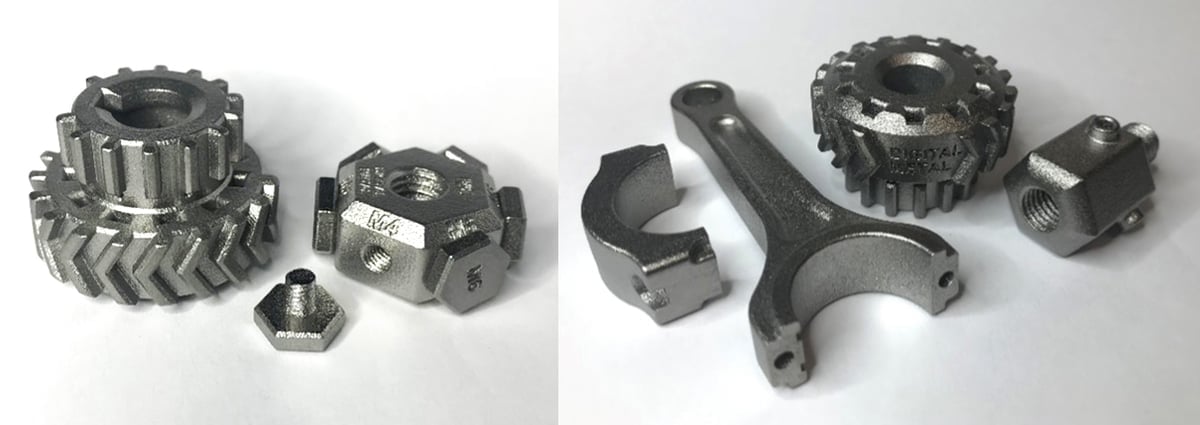
In fact, nearly every industry that uses metal parts has benefited from the time, money, labor, and material savings offered by metal 3D printing in all of its various forms and technologies.
Third-party 3D printing services also have matured in their offerings, eliminating the overhead of maintaining your own system. Through on-demand metal part 3D printing services, you can get guidance on materials and design or opt to simply upload your part’s digital file, select your metal material, and have your parts shipped from a provider near you.
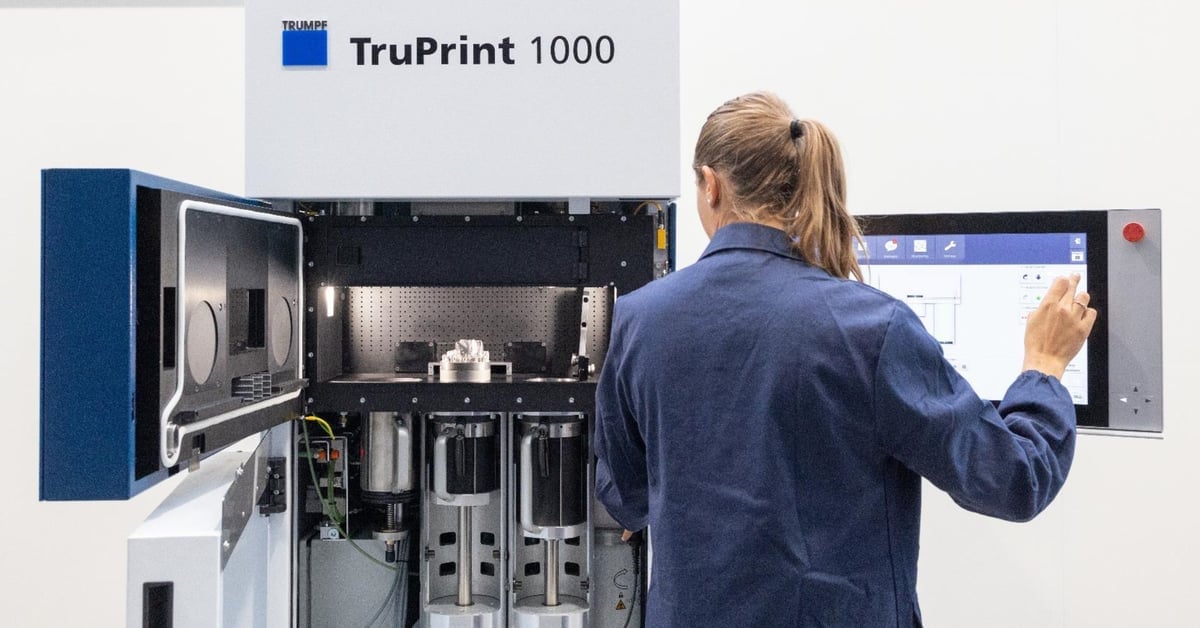
What’s New in 2025?
Every few months, we update our extensive coverage of the most trusted names and most innovative machines in metal 3D printing and explain the technologies behind them. Since our last update, new metal 3D printers were launched from Farsoon, EPlus3D, Meltio, and EOS, which we cover below, along with a new metal option on Markforged’s FX10 3D printer.
The major update for our metal printer guide in the last year has been the addition of desktop 3D printers that produce real metal parts from metal filament. Most of these machine options are not exclusive to metal materials but are gaining ground as affordable entry points into metal 3D printing. For some businesses and applications, 3D printing with economical metal filament is the ideal solution, but it’s not without its challenges, including the recent bankruptcy of the main provider of metal filament, Ultrafuse by Forward AM, although the company plans to restructure and bounce back.
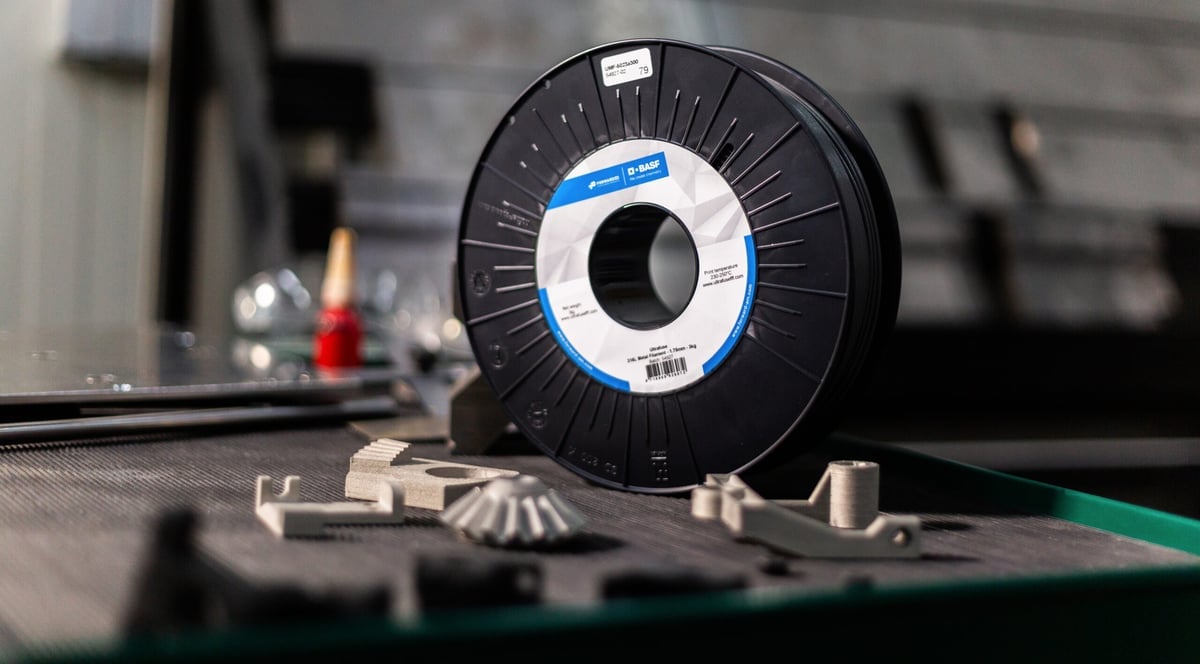
Which Metal 3D Printing Is Right for You?
If you’re looking for your first metal 3D printer, ask yourself these questions to narrow down your options:
- What metal(s) do I want to print with?
- What mechanical properties do my final prints need?
- How much do I expect to print in a week and how fast do I need them?
- Are my final metal parts for a regulated industry?
- Can existing staff operate the machine or do I need new expertise?
- Does my printer maker or distributor offer consulting and support?
All3DP covers all the ins and outs of purchasing a professional 3D printer in our popular guide: “Business 3D Printers: How to Make a Purchasing Decision”.
If you’re unfamiliar with the 10 metal 3D printing technologies, skip to the overview section on metal technology. However, if you’ve already narrowed down which metal 3D printing technology you want, check out our guides below covering the best machines in specific metal 3D printing technologies.
- Laser Powder Bed Fusion (LPBF) / Selective Laser Melting (SLM)
- Metal Binder Jetting
- Fused Deposition Modeling (FDM) with Metal Filament
- Cold Spray
- Wire Arc Additive Manufacturing (WAAM)
- Electron Beam Melting (EBM)
- Directed Energy Deposition (DED)
Who’s On The List?
Let’s get into it and take a look at the printer manufacturers at the forefront of the current metal manufacturing revolution. These are certainly not all the printers on the market and not all of these may be available in your country, but when starting your hunt for a metal 3D solution, this is a good place to start.
Our list includes the top names in metal 3D printers, focusing mainly on their entry-level offerings. Many of these companies offer a range of larger, production-ready machines so it’s worth keeping your growth plans in mind when shopping for a metal printer and considering companies offering scalable systems.
All of these printers are ideal for custom metal parts, tooling, and replacement parts, while many can handle low-to-mid-volume production runs or large complex metal parts for high-tech and regulated industries. Now, let’s dive into the best companies making the top metal 3D printers today.
| Metal 3D Printer | Technology | Build Volume in mm | Feedstock | Used For | Aprox. Price* |
|---|---|---|---|---|---|
| BCN3D & UltiMaker | FDM | 330 x 240 x 300 | metal-infused polymer filament | Spare Parts, Prototypes | $10,000 - $14,000 |
| Raise3D Forge1 | FDM | 300 x 300 x 300 | metal-infused polymer filament | Spare Parts, Prototypes | $8,500 |
| Rapidia Conflux 1 | FDM | 200 x 280 x 150 | metal paste | Spare Parts, Prototypes, Tooling | $99,000 (with sintering furnace) |
| One Click Metal MPrint+ | LPBF | 150 x 150 x 150 | metal powder | Spare Parts, Prototypes | $100,000 |
| Xact Metal XM200G Printer | LPBF | 150 x 150 x 150 | metal powder | Spare Parts, Prototypes, Dental | $120,000 |
| Markforged Metal X | FDM | 300 x 220 x 180 | bound powder filament | Spare Parts, Prototypes, Tooling | $115,000 |
| Desktop Metal Studio System 2 | FDM | 300 x 200 x 200 | bound powder filament | Spare Parts, Prototypes, Production Parts, Tooling | $135,000 |
| Meltio M600 | DED | 300 x 400 x 600 | metal wire | Spare Parts, Tooling, Heavy Industry, Machinery | >$200,000 |
| Eplus3D EP-M150 | LPBF | 153 x 153 x 120 | metal powder | Spare Parts, Tooling, Machinery, Medical/Dental, Aerospace | $145,000 |
| Kurtz Ersa Alpha 140 | LPBF | 140 x 140 x 200 | metal powder | Spare Parts, Tooling, Machinery | $165,000 |
| Desktop Metal Shop System | Binder Jetting | 350 x 220 x 200 | metal powder | Spare Parts, Tooling, Production Parts, Machinery | $157,000 |
| 3D Systems DMP Flex 100 | LPBF | 100 x 100 x 90 | metal powder | Spare Parts, Tooling, Production Parts, Machinery, Medical/Dental | $150,000 |
| Trumpf TruPrint 1000 | LPBF | 100 x 100 x 100 | metal powder | Spare Parts, Tooling, Production Parts, Machinery, Medical/Dental, Aerospace | $170,000 |
| Desktop Metal InnoventX | Binder Jetting | 160 x 65 x 65 | metal powder | Tooling, Production Parts, Machinery, Medical/Dental, Aerospace | $250,000 |
| Colibrium Additive Mlab R | LPBF | 90 x 90 x 80 | metal powder | Spare Parts, Tooling, Production Parts, Machinery, Medical/Dental, Aerospace | $250,000 |
| Renishaw RenAM 500 | LPBF | 250 x 250 x 350 | metal powder | Spare Parts, Tooling, Production Parts, Machinery, Medical/Dental, Aerospace | $250,000 |
| Markforged PX100 | Binder Jetting | 203 x 180 x 69 | metal powder | Spare Parts, Tooling, Production Parts, Machinery, Medical/Dental | $250,000 |
| HP Metal Jet S100 | Binder Jetting | 430 x 309 x 170 | metal powder | Spare Parts, Tooling, Production Parts, Machinery, Medical/Dental | $399,000 |
| EOS M 290 | LPBF | 250 x 250 x 325 | metal powder | Spare Parts, Tooling, Production Parts, Machinery, Medical/Dental, Aerospace | $390,000 |
| Nikon SLM Solutions SLM 125 | LPBF | 125 x 125 x 125 | metal powder | Spare Parts, Tooling, Production Parts, Machinery, Medical/Dental, Aerospace | $400,000 |
| Velo3D Sapphire | LPBF | 315 x 315 x 1000 | metal powder | Tooling, Production Parts, Machinery, Medical/Dental, Aerospace, Heavy Industry | >$500,000 |
| Farsoon FS121M | LPBF | 120 × 120 × 100 | metal powder | Tooling, Production Parts, Machinery, Medical/Dental, Aerospace, Heavy Industry | >$500,000 |
| AddUp FormUp 350 | LPBF | 350 × 350 × 350 | metal powder | Tooling, Production Parts, Machinery, Medical/Dental, Aerospace, Heavy Industry | >$500,000 |
| DMG Mori Lasertec 12 SLM | LPBF | 125 x 125 x 200 | metal powder | Tooling, Machinery, Medical/Dental, Aerospace, Heavy Industry | >$500,000 |
| BLT S210 | LPBF | 105 x 105 x 200 | metal powder | Spare Parts, Tooling, Production Parts, Machinery, Medical/Dental, Aerospace | >$500,000 |
For Small Replacement Parts
BCN3D & UltiMaker

Metal filament that produces metal parts is rapidly disrupting metal 3D printing in general. Solid metal parts from a roll of metal-infused polymer filament have dramatically expanded access to 3D printing metal for a wide audience of professionals who had been priced out of the technology.
Today, it is used for everything from small replacement parts to injection molds. Once a novelty, real metal parts from desktop-size 3D printers using metal-infused filament is becoming serious business. Yet, the ease of use of metal filament may have been overestimated by users. In 2024, as mentioned above, we say the bankruptcy of the main provider of metal filament, Forward AM, along with the closure of one company that offered a printer suited to metal filament, Zortrax.
Certainly, metal filament it has it benefits as an entry to metal 3D printing. It can be up to 90% cheaper than other metal 3D printing technologies for single pieces or low-volumes, it eliminates many of the safety concerns associated with metal 3D printing including loose metal powder and lasers, all while offering the same design freedom and good part quality.
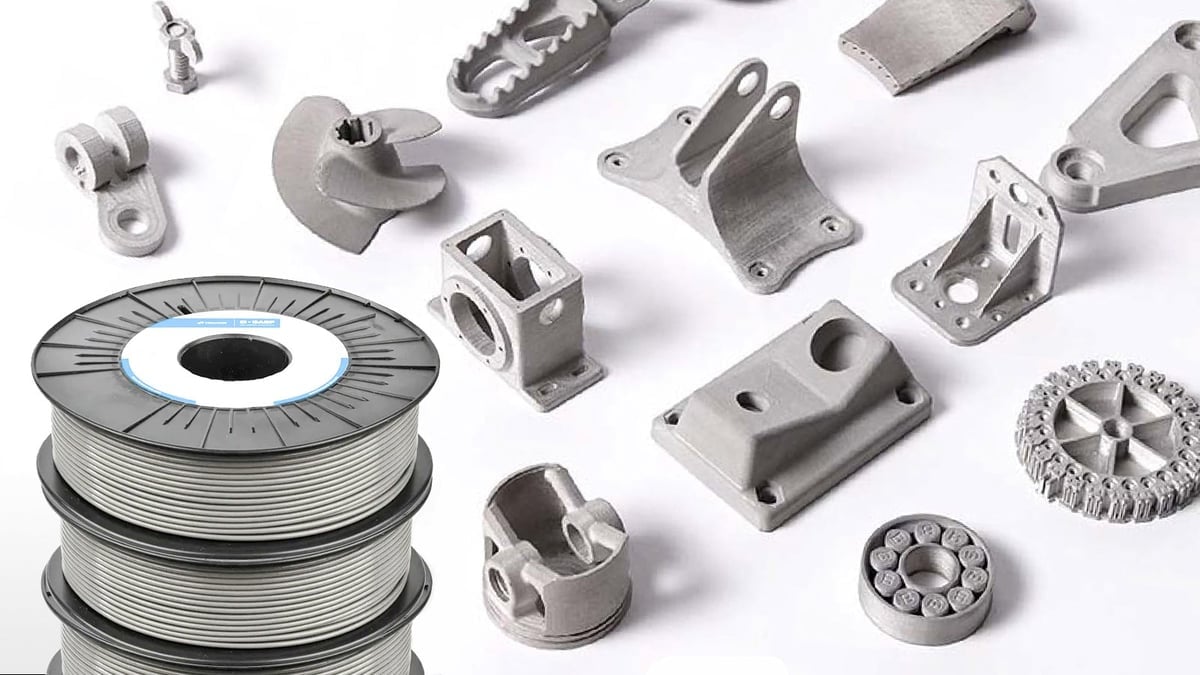
However, 3D printing with metal filament requires expertise, and it’s not right for every application. One of the main drawbacks of metal filament 3D printing is the required debinding and sintering post-processing steps.
Theoretically printable on a wide range of desktop FDM 3D printers, only BCN3D, UltiMaker, and Raise3D so far offer a full solution or kit of hardware, software, and accessories designed to ensure successful printing of Ultrafuse. Because Ultrafuse filament in 316L stainless steel or 17-4 PH stainless steel costs about $500 for a spool of 3,000 grams, having to experiment is costly.
BCN3D and UltiMaker offer partnerships with third-party post-processing facilities where you can send your parts to be finished, while Raise3D offers a debinding unit and a sintering furnace to accompany its Forge1 metal filament 3D printer (see below).
Raise3D Forge1

The Forge1 from Raise3D is a large-format metal 3D printer and part of the company’s MetalFuse solution, which includes the printer ($8,500), the D200-E debinding device, and the S200-C vacuum sinter furnace that can reach 1,500 ℃.
The MetalFuse system prints with Forward AM Ultrafuse stainless steel filament, like the desktop FDM printers mentioned above, but Raise3D is the first company out of the gate with a complete three-part solution so you don’t have to send your parts to a third-party provider for post-processing.
Raise3D says it can offer a streamlined workflow for in-house metal part production that also includes software that automatically accounts for print shrinkage so that the final size after debinding and sintering will be accurate.
The Forge1 printer boasts a dual-extruder, automatic bed leveling, filament run-out sensor, and HEPA filter with activated charcoal.
The dual-extruder comes in handy printing with the Ultrafuse Support Layer, currently only available in Europe, which is an aluminum oxide material used for “layer isolation”. In other words, it enables breakaway supports as a separation layer between the support and the prints after sintering.
The Raise3D aims the Forge1 at small-scale production of metal end-use parts. Printed metal parts are 97% dense metal. The company recently announced a new service where, for Forge1 owners, it validates and optimizes your 3D model design to ensure that it will achieve the best printing and post-processing results.
Ultrafuse 316L stainless costs about $500 for a spool of 3,000 grams. The 17-4 PH stainless steel is a little cheaper.
Rapidia Conflux 1

Although just now emerging from development mode, the Rapidia Conflux 1 (formerly Deisgnlab) is too interesting not to mention here. It uses a water-based paste material inlaid with metal or ceramic powders. Parts do not require a debinding step before sintering.
Designed for an office environment and easy to operate, the Conflux 1 from Rapidia is offered with a sintering unit and software. This machine isn’t technically FDM because it doesn’t use a filament, but it is an extrusion-based technology. The metal paste replaces 98% of the plastic binder with water, which evaporates while printing. Rapidia eliminates the debinding requirements and accelerates final part delivery times to simple overnight sintering, the company says.
The Conflux 1 printer is paired with a vacuum sintering furnace, and an updated version is due out soon. Further cutting costs, the Conflux 1 furnace sinters some common metals, such as 316L, in standard Argon gas. With a hot-wall furnace design, it is also much more energy efficient than typical sintering furnaces, the company says, using just 62kWh for a sintering cycle. Next to metal, gas is the second largest expense in a system that requires sinter post-processing.
Current materials include 316L stainless steel, 17-4PH stainless steel, and Inconel 625. In development, the company says, are D2 Tool Steel, copper, cemented tungsten carbide, and titanium.
One Click Metal MPrint+
One Click Metal started as a spin-off from well-known printer maker Trumpf with the goal of producing affordable, easy-to-use metal 3D printing systems perfect for companies new to metal laser powder bed fusion (LPBF) technology. One Click Metal works with cartridges eliminating the mess of metal powder, and it’s meant to be deployable with fewer requirements in terms of accessories and space.
It has a build volume of 150 x 150 x 150, comes with the MPrep software, and is meant to be paired with the MPure, which is the company’s 3-in-1 unpacking station that depowders the component, screens the powder, and provides recycled powder for reuse. The cartridge system of both the printer and the depowder station ensures easy and safer handling so that you have limited contact with the powder. With the side connection for a vacuum cleaner, you can efficiently remove excess powder from the unpacking chamber. The printer and unpacking station are sold as a bundle called the Boldseries.
The MPrint+ printer comes with a signal 200-watt fiber laser power generating a spot size of 70 microns. This affordable metal solution is also relatively zippy at a scanning speed of up to 12,000 mm/s and produces parts with a 20 to 80-micron layer height. Metal options include aluminums, coppers, steels, nickels, and titaniums.
Xact Metal XM200G Printer
US-based Xact Metal offers two laser powder bed fusion 3D printers with the aim of offering “speed & performance at an affordable price,” the company says.
The XM200G integrates a high-performance galvanometer system to move the laser beam over the powder bed. The printer offers the option of using two lasers simultaneously with either a 100% overlapping work area using a 100 µm spot size or a 66% overlapping work area using a 50 µm spot size. This multi-laser system further increases build print speeds. Plus you can select from one or two 100-, 200-, or 400-watt fiber lasers.
Xact Metal says the XM200G is aimed at companies that are just starting their entry into metal 3D printing in various applications, including product development and tooling manufacturing. The machine is highly configurable to match different applications and to keep costs down, some features are optional, such as the glovebox option to ease powder handling and additional sensors for build monitoring.
Finely detailed parts are possible due to the machine’s laser spot size range (50 or 100 μm) with a minimum layer thickness of 20 microns.
The XM200G is relatively small with a 150 x 150 x 150 mm build volume, but the new XM300G is much bigger (300 x 300 x 350 mm) and features more powerful lasers 400W or 700W fiber lasers. Metal options include aluminums, coppers, steels, nickels, and titaniums. The laser scan speed is up to 34,600 mm/sec.
Markforged Metal X

Similar in concept to filament 3D printing with metal filament, Markforged uses its own metal infused polymer material and adds features, such as breakaway supports, that make metal extrusion easier and more predictable. The metal 3D printing process used in the Markforged Metal X, called Atomic Diffusion Additive Manufacturing (ADAM), involves the process of using a bound metal powder filament. The resulting parts are then put into a debinder and sintered in separately available workstations.
Markforged, is a company that’s currently in a unfinished takeover by 3D printer maker Nano Dimensions, the same company acquiring the printer maker Desktop Metal. That aside, the Metal X remains a popular machine.
Boasting a compact footprint and slicing software with printer and print management features, the Metal X aims to be an easy-to-use machine that promises to take your parts from design to fully functional metal parts in as few as 28 hours.
The printer itself (about $115,000) and the two post-processing components comprise the complete Metal X setup, with a total price in the region of $150,000, including close support from Markforged itself with its three-year “success plan”.
The main metal feedstock is used as support material, with a fine ceramic interface layer printed between supports and part to ensure clean breakaway post-sinter. (The Ultrafuse filament used on the BCN3D, UltiMaker, and Raise3D mentioned above also has a ceramic-type interface material, but is only available in the EU). The Metal X can print parts from proprietary filaments in 17-4 PH stainless steel, copper, H13 tool steel, Inconel 625, A2, and D2 tool steel.
If the ability to 3D print metal and plastics, such as continuous-carbon-fiber-infused nylon, on one machine is attractive to you, Markforged announced in 2024 that its new FX10 extrusion 3D printer originally designed for polymers can now, with adaptors, print metal. The FX10 Metal Kit ($19,000) consists of a swappable print “engine” that includes a metal-specific print head, material feed tubes, routing back, and dual pre-extruders. The swap takes about 15 minutes.
Desktop Metal Studio System 2

Despite the fact that Desktop Metal, the company, is on shaky ground amid a contentious buyout, its Studio System 2 metal 3D printer can’t be thrown off this list.
It has been very popular over the years as an office-friendly, metal entry point offering parts in a range of metals, including titanium, not just stainless steel. It extrudes a metal filament (in the form of rods) to create the desired geometry (similar to the Markforged above), but it doesn’t need a debinding step to remove the plastic binder that holds the metal powder into a filament – or the associated equipment – when printing with 316L stainless steel. Prints from the Studio System are moved directly into the accompanying furnace that first heats parts to remove all binders from parts, then ramps up the temperature to near-melting for sintering.
Desktop Metal offers a separable supports technology that automatically generates seams throughout support structures, and prints a reformulated ceramic interface material between the support structure and the part, allowing parts to easily be removed by hand.
Easing you into the process of printing metal parts is the company’s software called Fabricate which automates a lot of the process, such as automatically scaling your part (to account for sinter shrinkage), orienting it for ideal print and sintering success, and generating the separable supports. Upload your design and follow the onboard UI for step-by-step guidance, the company says.
The Studio System 2 is compatible with only proprietary materials, which include H13 tool steel, 17-4 PH stainless steel, 4140 steel, copper, titanium Ti64, and D2 tool steel, but these require a separate debinding station. So far, only the 17-4PH stainless steel, 4140 low-alloy steel, D2 tool steel, and 316L stainless steel are printer-to-sinter compatible.
The Desktop Metal Studio System 2 sells for approximately $110,000 for the complete system, including the furnace station.
For Batch Manufacturing
Meltio M600

Meltio, which makes a host of wire-laser metal deposition systems, aims to make the technology less intimidating and more accessible for machine shops and small to mid-size manufacturers with its newest addition, the M600 launched in 2024. The M600 is intended to integrate into production environments alongside equipment like CNC machines, to not only print metal parts but also add features to existing components and repair damaged surfaces.
The M600 offers a range of automatic features that Meltio hopes will ease the introduction of laser wire direct energy deposition (DED) technology into more places, outside of its current niche areas, where it can offer increased metal part production speed with less waste. DED technology does not have the fine accuracy of LPBF but it is a fast solution for near-net shapes that can be later machined to tighter tolerances.
Designed to perform 24/7 with minimal operator interaction, the M600 is a 3-axis 3D printer that uses common welding wire as its feedstock, which is much cheaper than metal powder and safer to handle. Available materials include stainless steels, titanium alloys, and nickel alloys, as well as reflective materials, such as copper and aluminum alloys.
Meltio says the material properties of parts from the M600 are comparable to conventionally manufactured parts. New for laser DED technology is Meltio’s use of a blue laser it says increases printing speed while reducing energy consumption. This short wavelength light combined with the enclosed printer’s fully inert workspace, expands the available range of materials.
Meltio Horizon, the dedicated slicer for the Meltio M600 and the backbone to its automation, features a simpler profile selection and premade profiles that cover a large range of geometries and qualities. Workers can select stored presets and the machine workspace adjusts automatically. Engineers can use the slicer to also configure different sections of the build for print quality and speed and generate infills, including gyroid lattices.
Eplus3D EP-M150

Eplus3D now offers 12 industrial metal powder bed fusion machines, which begs the question: How many options do manufacturers need? The company offers a dizzying menu of build volumes and laser counts. The latest addition launched in January 2024, the quad-laser EP-M400S, builds on the success of the EP-M400 launched in April 2023, the company says. This new model brings “significant enhancements” including a new top-feeding powder hopper and bi-directional powder re-coating, which reduces powder-spreading time by up to 30%.
The EP-M400S is also 10% smaller than the non-S version while reducing the build volume just a touch from 405 x 405 x 450 mm to 400 x 400 x 450 mm.
The smallest metal solution from Eplus3D is their EP-M150 LBPF machines designed for batch manufacturing of dental parts, medical implants, and material research, the company says. The company’s largest offering, with a build volume of 1,558 x 1,558 x 1,100 mm, is its EP-M1550.
The EP-M150 is a low-cost machine to operate, the company says, which is a feature after-thought for many purchasers but can drastically affect the bottom line. The machine has a powder feeding and sieving system that enables high material utilization, low gas consumption (0.8 l/min), and a tightly sealed chamber that minimizes gas leakage. The machine also features a clear UI and various security technologies for specialized industries.
Eplus3D also has a technical consulting team to help you select the right solution or to go with their contract additive manufacturing option. They can also help you figure out how to use advanced additive manufacturing to develop completely new business models, improve the efficiency of your existing productions, and create manufacturing innovations.
Kurtz Ersa Alpha 140

Kurtz Ersa, the giant German machine maker and technology corporation, got into the 3D printing market in 2021 with the Alpha 140. The aim was to deliver an entry-level metal printer with simple operation at a low cost for small and medium-sized companies.
Featuring an open perimeter system, you can develop your own processes by adjusting the slicer according to individual requirements. The machine features a 200W fiber-coupled diode laser with a 110-micron focus diameter for fine details and thin wall thicknesses.
The Alpha has a small footprint so you can produce parts in stainless steels, tool steels, and nickel-based alloys on any size shop floor. Kurtz Ersa says the Alpha 140 can achieve metal part strengths comparable to larger LPBF machines and has a metal part density of up to 99.9%.
An optional laminar shielding gas flow creates more optimum conditions for the inert welding process while keeping the laser optics protected. There’s also a proprietary LMI SliceAM software that integrates with Autodesk Fusion 360 and Autodesk Netfabb CAD programs.
Kurtz Ersa has a larger, 8-laser, machine in the works, called Flying Ray, so stay tuned.
Desktop Metal Shop System

Where Desktop Metal’s Studio System 2 provides an efficient route to metal one-offs, prototypes, and custom tooling, the Desktop Metal Shop System scales things up, swapping bound metal deposition technology for metal binder jetting technology to enable faster throughput of parts – all in a modestly-sized workshop-suitable form.
Designed with machine shops in mind, the Desktop Metal Shop System is available in a variety of build volume configurations (up to 12-liter capacity) and offers the capability to group different batches of parts into single print cycles – tooling-free – rattling off the full volume of parts within a typical shift.
The Shop System uses Desktop Metal’s own spin on binder jetting, with more than 70,000 nozzles depositing droplets of binder in a single pass onto the company’s proprietary metal powders. The company claims surface finishes as fine as 4 Ra microns are possible post-furnace.
The company also offers a larger metal binder jetting solution called the Production System, featuring what the manufacturer calls Single Pass Jetting technology that boosts speed.
If you’re wondering how the three metal binder jetting options on the market stack up, we compare them in this article linked below.
The Production System’s open platform accepts low-cost non-uniform powders, such as those used for metal injection molding. That means manufacturers can continue to use their preferred MIM powders, or source locally. The Production System’s print parameters are adjusted to match.
Desktop Metal qualifies a variety of stainless steels, low-alloy steels, tool steels, along with copper, nickel alloys, and precious metals and can work with you on your metal of choice.
3D Systems DMP Flex 100

3D Systems’ entry-level DMP Flex 100 metal 3D printer offers a build volume of 100 x 100 x 90 mm and the ability to print parts with overhangs down to 20 degrees without supports. Surface features as fine as 5 microns should mean a minimal need for post-processing. 3D Systems calls its metal laser powder bed technology Direct Metal Printing, where each layer is melted onto the previous one creating a strong and dense part (up to 99.9%).
The system’s 100-watt fiber laser, while lower power than those of the larger metal 3D printing solutions in 3D Systems’ lineup, is powerful enough to handle a broad selection of the company’s metal powder library, including a variety of titanium grades.
Tailored to niche uses that demand fine detail, the DMP Flex 100 makes use of dedicated gas lines to achieve the vacuum necessary to print 3D Systems’ additive manufacturing-optimized powders. As such, it requires the necessary building infrastructure to facilitate this.
If you’re ready to move up from entry-level machines, 3D Systems offers five other, larger production units plus a networked factory solution called the DMP Factory 500 featuring three 500-W fiber lasers and a 500 x 500 x 500 mm build volume.
Trumpf TruPrint 1000

Germany-based Trumpf launched the TruPrint 1000 LPBF in 2019 for the production of small industrial parts and, without changing the name, has since made a range of upgrades to the machine.
The “next generation” TruPrint 1000 has a full-field multi-laser capacity and what the company calls a “completely redesigned homogeneity of the gas flow” and it now fits through a standard door frame. Trumpf says this printer is aimed primarily at the dental industry.
The printer’s two 200-watt fiber lasers scan the build area simultaneously, which the firm claims can increase productivity by up to 80% when compared to similar machines. A powder bed monitoring system analyzes each layer for maximum part quality. A tilting recoated makes the powder application process faster, which further increases production speed and cuts part costs.
There’s also a multiplate option for volume production. The build cylinder can optionally accommodate up to four substrate plates, meaning the substrate plate can be exchanged automatically without stopping the LMF process. The machine software provides fully automatic support once the first build job is complete and the next one is being started. Completed build jobs are collected in an overflow bin.
TruPrint 1000 can process amorphous metals. These materials make it possible to produce parts with high elasticity and corrosion-resistance, while simultaneously cutting down on wall thicknesses. This reduces production times and final part weight.

Trumpf has seven other metal 3D printers in its portfolio of varying sizes and capacities. The TruPrint 1000 Green Edition features a green laser that enables it to 3D print highly reflective materials, such as copper and its alloys. Other machines in the company’s catalog scale power and production capacity up to higher-volume applications.
Trumpf‘s TruPrint 2000 3D printer now has more laser power — 500 watts instead of 300 watts — and a square build plate instead of a round one. There’s also a motorized beam expander that automatically adjusts the laser spot diameter (55 or 80 microns) according to the task at hand for more detail.
Desktop Metal InnoventX

Desktop Metal inherited the metal binder jet technology and patented materials of its closest rival ExOne when it acquired the company in 2021. Since then, those machines have seen some upgrades, including new names: InnoventX, X25Pro, and X160Pro. ExOne was one of the pioneers of the commercialization of metal binder jetting almost two decades ago.
The X-Series differs from Desktop Metal’s Shop and Production systems in a number of ways. X-Series machines can all process ceramic powders, such as alumina and aluminum nitride, in addition to sand, “composite powders”, and metal powders.
The X-Series has what the company calls Triple ACT (Advanced Compaction Technology), which is a patent-pending way of dispensing, spreading, and compacting metal powders in the printing process. X-Series systems can achieve dimensional tolerances of less than 1%, the company says. By comparison, the Production System has ±2.0% dimensional tolerance.
Another difference between the X-Series and the Shop Systems is the print heads. The Shop System uses a less expensive thermal printhead, whereas the X-Series and Production System printers use piezo printheads. Desktop Metal says piezo printheads may have higher resolution, better durability, and more performance and material options. The X-Series printers also do not feature an inert environment like the Production System.
The InnoventX is the company’s machine aimed at educating students, researching in labs, or getting started with application development. The InnoventX could be considered the step before the X25 Pro or the X160Pro. Its print speed is just 54 cm3/h.
Colibrium Additive Mlab R

Industrial powerhouse GE spun off its additive manufacturing division in April 2024 as Colibrium Additive. It currently offers nearly a dozen metal 3D printers in various technologies, including electron beam melting, laser powder bed fusion, and is developing a metal binder jetting option.
Colibrium Additive’s LPBF machines (which it acquired from a company formerly known as Concept Laser) range from the smallest single laser Mlab R (90 x 90 x 80 mm) to the massive dual-laser X Line 2000R (800 x 400 x 500 mm). Mlab R can process an impressive list of reactive and non-reactive materials and produces fully dense parts with a surface finish that’s smoother than most. The small build volume is designed for research, prototypes, and precious metal parts. The modularity of the build chamber allows for quick and efficient material changes, and the semi-automatic sieving station enables powder reuse. The Mlab 200R version has a more powerful laser (200W) and the option of a larger build volume (100 x 100 x 100 mm).
Colibrium Additive is better known for its EBM machines, which are widely used in the medical industry for orthopedic implants and in aerospace for parts such as turbine blades. The EBM line boasts dimensionally accurate parts quickly and efficiently with a high-power electron beam for high melting capacity and productivity.
Renishaw RenAM 500

Placing emphasis on productivity, Renishaw’s RenAM 500 line is available in several configurations of one or four 500-watt lasers, each capable of hitting the entirety of the build volume. This enables the RenAM 500 to accomplish full-layer sinters quicker than single-laser systems, increasing output and, consequently, reducing cost per part.
In late 2024, the new RenAM 500D debuted. It has the same Tempus technology that allows the lasers to fire while the recoater is moving, improving overall efficiency. The machine has two 500-watt ytterbium fiber lasers, a beam focus diameter of 80 microns with dynamic focus, and a build volume of 250 x 250 x 350 mm.
There’s an automatic or flexible powder and waste handling in the 500 line. The flexible option enables you to change powders in-house while the automated system ensures operator safety and reduces the time required to operate and maintain the machine by recirculating. An “intelligent” gas flow system reduces both argon consumption and emissions.
The RenAM 500 features a typical build volume of 245 x 245 x 335 mm (substrate dependent) and can output some 150 cm3 per hour, depending on the geometries being printed and other material variables. The RenAM 500 series enables the production of components with >99.9% density, the company says.
Markforged PX100

Markforged is one of the leading 3D printer makers using extrusion technology for both metal and polymers, but to expand into metal binder jetting, it acquired the Swedish metal binder jet maker Digital Metal in 2022 and renamed the Digital Metal binder jet printer as the Markforged PX100, available in two sizes.
Originally designed to prove that metal binder jetting could produce quality parts, not as a commercial piece of equipment, the PX100 was a bit over-engineered, the company says. Yet that engineering has led to a precision and part quality that sets it apart, according to Markforged.
The base of the machine is a slab of granite that’s required to stabilize the unit and eliminate vibrations during printing. This is why the PX100 is nearly twice as heavy as any other metal binder jetting solution. There are also smooth linear motors and air bearings, which Markforged says leads to exacting precision and static accuracy better than 1 micron.
The company’s binder jet solution focuses on producing large batches of small and intricate metal parts. With its 250 × 217 × 186 print volume, it can make larger parts, but customers have opted for this solution for its ability to make hundreds or even thousands of small parts at a time, such as watch faces and medical instruments.
Markforged offers the full ecosystem of accessories covering depowdering and powder management with your choice of manual or automatic versions.
Because the method doesn’t require heat or a curing or drying step, there’s no lengthy cool down or heat up, and the time between batches can be as little as 15 minutes.
HP Metal Jet S100

HP Additive – yes, a branch of the same HP that makes 2D printers, laptops, and ground-breaking polymer 3D printers – unveiled its new and improved metal 3D printer in Sept. 2022. Called Metal Jet S100, it’s aimed at industrial-scale metal part production. In 2024, HP boosted the print volume a bit adding 30 mm to the height, introduced new tool steel and 316L stainless steel materials.
The company debuted the Metal Jet technology in 2018 and had some high-profile applications (Volkswagen, Cobra Golf) but did not release the machine commercially. Instead, it has worked closely with select companies in various industries on beta testing new features and processes before rolling out the S100.
The HP S100 metal 3D printer uses binder jet technology, which is a method of 3D printing that uses a liquid binding agent deposited in tiny drops on powdered materials in layers to create solid, complex shapes. As the build progresses, the print layers are bonded together, resulting in a powder box with the desired part geometry inside. The process is similar (but not identical) to HP’s polymer Multi Jet Fusion (MJF), only that it uses metal powder, specifically stainless steel (316L and 17-4PH).
Binder jetting has several advantages over traditional metal injection molding and other forms of metal 3D printing, depending on your requirements. The technology especially shines regarding speed since printheads typically work faster than lasers or electron beams. There’s also a far lower material cost with binder jetting because it can use the same commonly available metal powder as injection molding.
Using a thermal inkjet to precisely deliver HP binding agent to a powder metal bed of industry-standard materials, the Metal Jet yields green state parts that are up to 99% metal by volume. This also cuts down on the time-to-part by drastically reducing the need for debinding. HP Metal Jet parts, once printed, need only decaking and can be directly sintered in a furnace before further finishing steps.
HP seems to have taken the typical metal powder bed printing hazards out of the equation with its integrated platform, but it does appear to require investing in seven or eight pieces of equipment. A powder management station mixes and sieves the powder (much of which can be reused from previous prints) and fills the build unit, which then goes to the 3D printer. After printing, the build unit goes to the curing station and then to the powder removal station. At this point, the part is ready to be sintered in any industry-standard sintering furnace, after which it can be machined or finished if necessary.
For Aerospace & Defense
EOS M 290

The smallest LPBF machine from EOS is now the M 290, which was introduced in 2014. The company discontinued the smaller M 100 in 2022, presumably ceding space in the entry-level, low-wattage category to the newer start-ups. And why not? EOS has a solid footing in production manufacturing and 3D printing service bureaus with its three larger machines, the M 300, M 400, and M 400-4. The larger machines focus on higher productivity with larger build volumes and more lasers.
In 2024, EOS launched its new M 290 1kW initially focusing on copper (CuCp and CuCrZr). The boost in laser power to 1,000 Watts isn’t completely unexpected. The manufacturer has been custom-fitting its machines with this power at its AMCM customization wing and decided it was time to let this unit out into the wild particularly to cater to customers in space, energy, and mobility.
In fact, the AMCM machines are some of the most specialized metal 3D printers on the market making parts for the CERN particle collider and combustion chambers for Launcher’s E-2 rocket engine.
EOS offers an impressive range of materials for its six core metal 3D printers with more than 20 alloys and 70 validated “processes” or printer settings to get predictable outcomes. The metal portfolio includes aluminum, cobalt chrome, nickel alloys, refractory metal, stainless steels, tool steels, and titanium.
Nikon SLM Solutions SLM 125

Germany-based SLM Solutions, acquired by Japanese manufacturing giant Nikon in Jan. 2023, offers a wide range of LPBF machines, the smallest of which is the SLM 125, the little engine that could. Its 400-watt fiber laser has more power than the lasers of other similarly sized machines, the manufacturer claims, which cuts powder consumption by up to 80%. SLM markets the printer toward research work and low-volume manufacturing.
The SLM 125, can process both reactive and non-reactive metal powders, and its reduced number of powder-transporting components makes swapping materials quick and easy. Laser power monitoring and layer control systems constantly check both laser output and layer consistency for high accuracy, eliminating irregularities. The 125 x 125 x 125 mm print envelope is sufficient for one-off parts and prototypes, especially with the wide variety of materials, including stainless steel, aluminum, and titanium. Research institutes and parts producers looking for power in a small package shouldn’t dismiss the SLM 125.
A nice feature in SLM Solutions’ technology is the ability to directly scale the production process with the company’s expansive catalog of other printers. The firm has a machine for pretty much every production level, with the latest model addition being the generously sized industry-level NXG XII 600 launched in late 2020. Its twelve 1,000-watt lasers and a 600 x 600 x 600 mm build volume provide not only size but speed – the company claims this is the fastest metal printer on the market. Nikon SLM recently began US production of the NXG XII 600.
In late 2024, Nikon SLM Solutions announced its newly redesigned SLM 280, SLM 280 Production Series, and SLM 500 machines promising to ensure a minimum of 85% uptime for customers, with a target of over 90% machine uptime.
Velo3D Sapphire

The Velo3D Sapphire “next-gen” metal 3D printer sets itself apart as a volume production system with the advantage of support-free 3D printing and a one-meter tall build volume. Using dual 1-kilowatt lasers in its 315 x 312 x 1,000 mm print space, the Sapphire can print in aluminum F357, Inconel IN718, Ti 6Al-4V Grade 5, and Hastelloy (a nickel-chromium-iron-molybdenum alloy) C22 and X, plus recently added the nickel-based superalloy powder Amperprint 0233 Haynes 282.
For Velo3D, support-free geometries mean the Sapphire can achieve prints with overhangs of zero degrees – flat surfaces on the horizontal plane, basically. In addition to saving time on post-processing prints, the printer is able to realize internal channels and volumes without consideration for support structures.
Velo3D also offers the new Sapphire XC printer, the name standing for “Extra Capacity.” True to its name, the Sapphire XC can increase production by five times compared to its sibling and reduce cost-per-part by 75%, the company claims. This XC has a build volume of 600 x 600 x 550 mm and eight lasers.
Velo3D announced in 2025 that its major financial restructuring will put Arrayed Additive with a 95% stake through its subsidiary Arrayed Notes Acquisition Corp. In late 2024, Velo3D entered into a licensing and support agreement with SpaceX, in a deal totaling $8 million.
Farsoon FS121M

Farsoon, the large Chinese 3D printer manufacturer, aims to cover all the bases of metal printing with a wide range of printer sizes. Its smallest is the FS121M. This flexible and open system enables you to select between multiple laser spot sizes, different recoating blades, and powder choices. The company offers an 8 x 1,000 W-laser machine, the FS721, and in 2024 just launched the latest edition to lthe ineup; the FS721M-8-CAMS, whew, that’s a mouthful. We’ll just call it Cams, which stands for Continuous Additive Manufacturing Solution.
This metal LPBF machine features an internal conveyor system, which the company says opens up new potential for series production with increased automation. Integrating eight 500W or 1000W lasers, Cams automatically transfers a completed build unit to an “inert breakout station” and loads a second build unit to start another print job. Billed as “continuous production capability” this system ensures minimal machine downtime between build jobs.
In addition to the print automation, the powder handling is also automated. The closed-loop powder handling system integrates multiple powder processes, including powder recycling, storage, sieving, and new powder supply.
Print speed on the Cams can be up to 300 cm3 per hour.
Farsoon’s FS273M laser powder bed fusion 3D printer (275 × 275 × 355 mm) has dual fiber lasers (2 × 500W) or a single 500W fiber laser. Its recoater design enables faster speed and more stable powder delivery throughout the whole manufacturing process, a preheated base plate, removable overflow containers, and a backup powder supply sufficient for a full build.
Farsoon machines are open platform systems, which means that all machine parameters are unlocked for the user as well as an open material policy.
AddUp FormUp 350

AddUp, the French 3D printer maker, debuted its powder bed fusion machine, called the FormUp 350 in 2021. It’s a modular, production-focused 3D printer featuring a material handling system that’s designed to store, move, recover and sieve powder within an inert atmosphere, preventing operators from being exposed to fumes and smelting residues.
The FormUp 350 is the only machine on the market with an interchangeable coating device. Choose the powder spreading system best suited to your production: a scraper system for maximum productivity, or a roller system for improved surface finishing. The recoaters can also bidirectionally recoat for 40% faster action. The company says that you can select from up to four 500-watt fiber lasers, each covering the entire platform surface, offering more freedom during build preparation. AddUp offers nearly a dozen metal powders.
Designed for mass production applications, the FormUp 350 machine limits the time between each production run to one hour or less, the company says. A cooling system for the machine’s Z-axis lowers the temperature of the platform at the end of production, allowing parts to be unloaded more quickly (2 hours to cool down from 200 to 65°C, compared to 12.5 hours without active cooling).
With a generous build volume (350 x 350 x 350 mm) and a range of features designed for production manufacturing, the FormUp350 boasts open parameters so you can tune to your needs.
DMG Mori Lasertec 12 SLM

DMG Mori started off in Germany as a tool-making company in 1948 and has grown with the times now offering a wide range of machines for turning, milling, grinding, and some acclaimed metal 3D printers. The company’s hybrid laser DED machines feature fast DED metal production with the fine-tuning of CNCing all in the same machine.
The Lasertec 12 SLM is a laser powder bed fusion 3D printer with a 200 W or optional 400 W laser featuring a 125 x 125 x 200 mm build volume.
Layer thickness can get down to just 20 microns and DMG Mori boasts an open platform enabling you to adjust parameters to your heart’s content and pair the machine with nearly any metal powder.
The machine’s automated rePlug powder handling tech integrates powder recycling for maximum efficiency and work safety due to the closed material cycle.
The company’s larger, Lasertec 30 Dual SLM features two 600-W lasers.
BLT S210

BLT (Bright Laser Technologies) is the metal 3D printer giant from China offering 12 metal 3D printers employing laser powder bed fusion technology, a massive metal print service, metal powders, and engineering expertise as a service. Supporting a long list of global manufacturers with hubs in China, BLT machines are widely used in automotive, aerospace, medical, and tooling applications.
The company’s smallest LPBF machine, the S210, features a 105 x 105 x 200 mm build volume, a 500-W laser, real-time monitoring, and a modular design. It runs on Materialise Magics software and BLT’s own BLT-BP and BLT-MCS. For materials, the S210 can handle titanium alloys, aluminum alloys, superalloy, cobalt-chromium alloy, stainless steels, tool steels, copper, tungsten, tantalum, and magnesium alloys.
Moving up in size and complexity and rest of BLT’s printers offer larger build volumes, higher wattage multiple lasers, bi-directional recoaters, and more production-ready features helping you track and monitor batch volume metal prints.
Considered the company’s flagship machine, the S310 features single or dual 500-W lasers and a 250 x 250 x 400 mm build volume.
Know Your Metal 3D Printing Tech
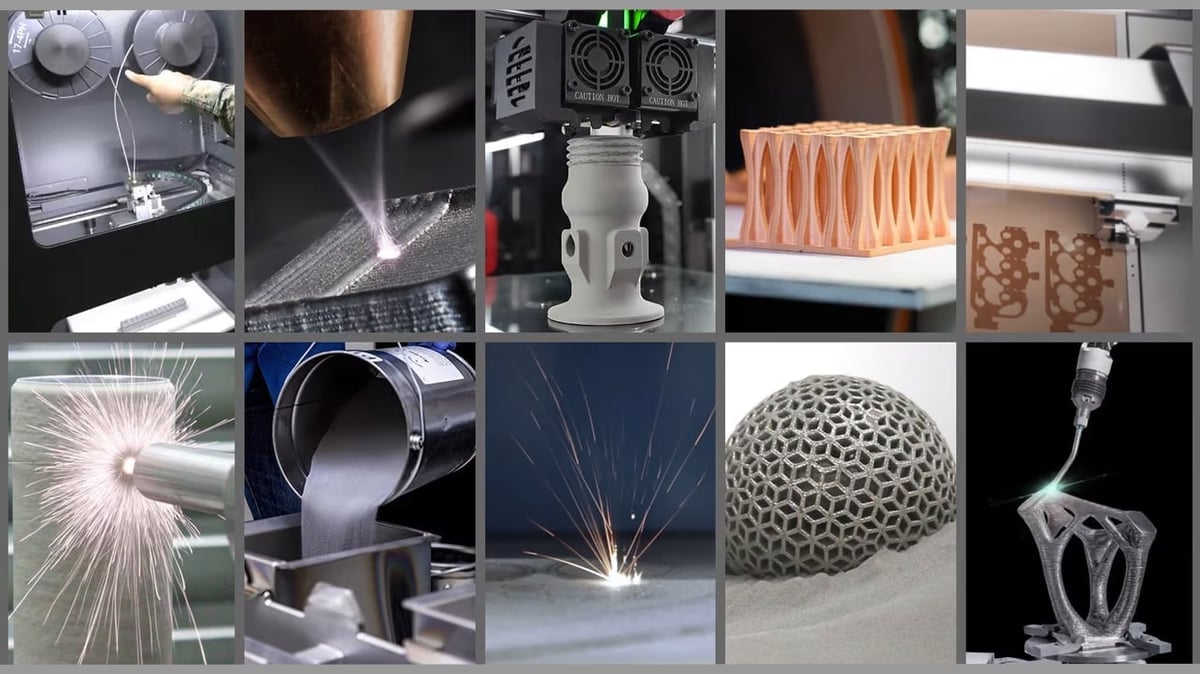
There are more than 10 ways to 3D print metal. The different technologies produce different parts and affect your overall cost, speed, and efficiency, so getting grounded in your options is essential. We’ll breeze over the options here, but we link to fuller coverage and explanations elsewhere at All3DP.
Laser Powder Bed Fusion (LPBF)
The most common metal 3D printing technology is laser powder bed fusion, more popularly known as selective laser melting (SLM) or simply metal fusion, which makes up about 80% of the metal 3D printer market.
LPBF can be used with a wide spectrum of materials – aluminum, titanium, steel, nickel, cobalt, copper-based alloys, and their composites – and involves a laser (or several) that slowly and steadily melts layer by layer of metal powder, fusing the tiny particles of metal.
Parts emerge from the LPBF processes ready to use without further steps required, except for possibly having to remove the support structures. However, the surface finish of the sintered parts is rough and may need some post-processing, depending on your requirements.
Fused Deposition Modeling (FDM) with Metal Filament
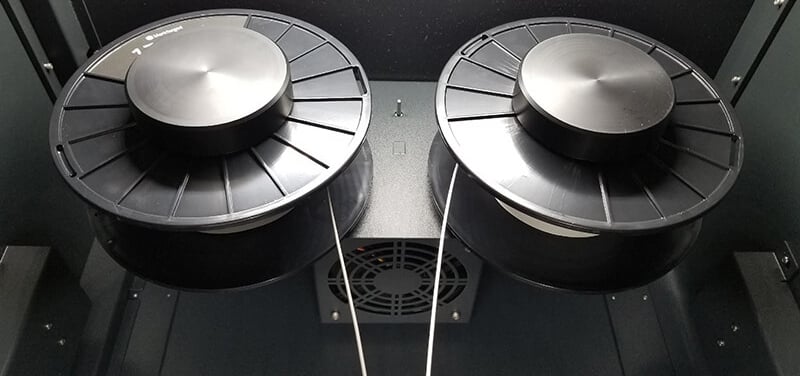
FDM, which uses filament extruded through a nozzle, is the workhorse of plastic 3D printing but turns into a metal printing technology with plastic filament infused with metal powder or nearly full-metal filaments. The plastic part of the filament (or binder) is removed in the post-processing to reveal a part that is up to 98% metal, although it can have relatively high porosity. Metal filaments are also abrasive to FDM machine extruders, so reinforced or hardened steel extruders are necessary.
Metal FDM is by far the least expensive way to produce metal parts because metal filament can be used on a wide range of desktop 3D printers originally designed for plastics, such as UltiMaker and Raise3D. In fact, there’s been a lot of buzz about using stainless steel filament on desktop 3D printers designed mainly for plastics. So what’s the difference between this method and the dedicated metal printers we feature below?
In short, it’s all about the structural and mechanical properties your parts require. That’s not to say that metal parts from these desktop printers are just decorative. They are real metal parts suited for a broad range of applications, including tooling, jigs and fixtures, small series production, functional parts, prototypes, and even jewelry. The FDM print method, however, is less accurate than other metal 3D printing technologies and this method requires supports, which can limit part geometry. Parts from metal filament also require debinding and sintering (often at a third party), slowing down your production.
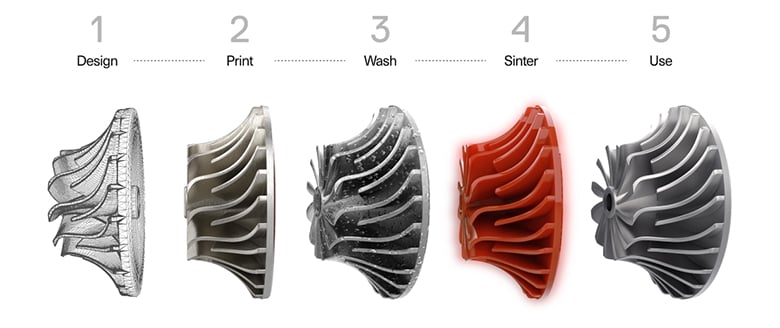
Electron Beam Melting (EBM)
EBM (also called electron beam powder bed fusion) is another powder-based technology that uses an electron beam instead of lasers to melt and fuse the metal materials fully. It’s less accurate than its laser cousin but can produce larger parts faster. The EBM process occurs in a vacuum and at high temperatures, resulting in stress-relieved components with material properties better than cast and comparable to wrought material.
Metal Binder Jetting
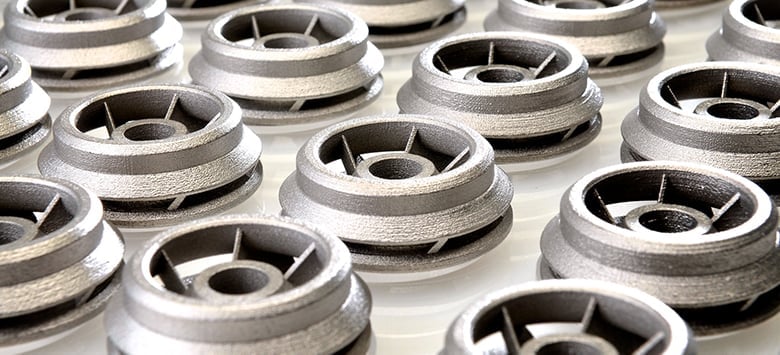
Binder jetting has really taken off in the last few years, potentially challenging LPBF in the next five to 10 years as the industry standard because of its speed and volume. A binder jet printer distributes a layer of metal powder and then uses a jetting head to deposit a binding polymer to create the geometry. Although the part is produced faster and in larger batches than any of the other powder bed processes, printing is only the first step. Just like FDM, post-processing, such as debinding, sintering, infiltration, and finishing the part, will often take more time than printing the initial part. This technology is used for batches of parts, so even with post-processing, it can be faster than other methods.
Cold Spray
Cold spray is a manufacturing technology that sprays metal powders at supersonic speeds to bond them without melting them, which produces almost no thermal stress. Since the early 2000s, it’s been used as a coating process, but more recently, several companies have adapted cold spray for additive manufacturing because it can layer metal in exact geometries up to several centimeters at about 50 to 100 times higher speed than typical metal 3D printers.
For additive manufacturing, cold spray is being used to manufacture metal replacement parts quickly and for on-location repairs and restoration of metal components, such as military equipment and machinery in the oil and gas industry, saving companies potentially millions in remanufacturing and interruptions in workflows. Repaired parts, in some cases, can be better than new ones.
Powder & Wire Direct Energy Deposition (DED)

Directed energy deposition (DED) technologies fuse materials by melting them as they’re being deposited, similar to welding. It’s a manufacturing process, like Cold Spray, that’s often used to repair and maintain existing metal parts, but can also quickly construct metal parts.
Several processes fall under this category and differ in the heat source and raw material. One, called wire arc additive manufacturing (WAAM), uses a metal wire and an electric arc to fabricate large metal parts that can then be machined to a final shape. Other DED technologies use metal wire with plasma, laser, or electron beam energy sources. At the same time, there’s also a popular technology using metal powder shot from a nozzle and melted with laser energy.
This is not an exhaustive list of metal 3D printing methods. More specialized metal 3D printing technologies include metal lithography and micro selective laser sintering for tiny metal parts.
Metal 3D Printing Services
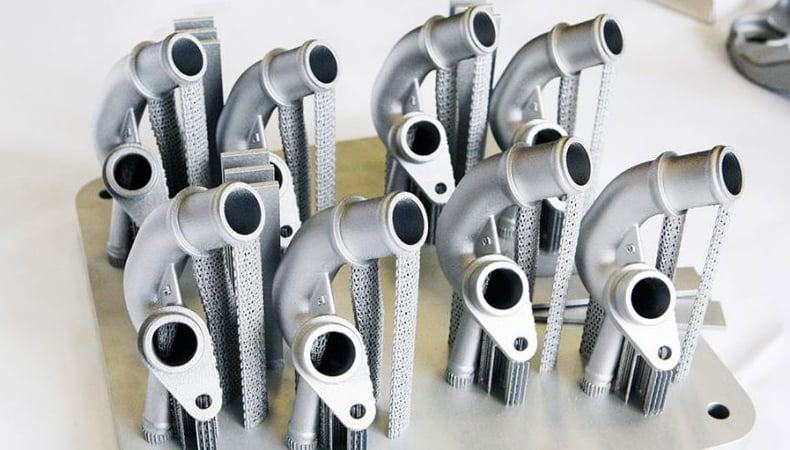
Investing in a metal 3D printer is no small decision, and part of any good due diligence is ordering sample parts. You can order these from the manufacturer, but many printer manufacturers on this list also offer print-on-demand services. For smaller projects, one-offs, and tests, outsourcing your 3D prints to a metal 3D printing service can dramatically save on the capital cost and overhead of operating your own system.
Third-party print services, such as Shapeways, i.Materialise, Sculpteo, and 3D Hubs, also offer metal printing. However choosing the right printing service for your needs can be a challenge. The best first step is to visit Craftcloud, the 3D printing service marketplace where you can instantly compare metal 3D printing prices for multiple parts in the same basket. The Craftcloud platform mixes and matches offers to give you the lowest cost and quickest turnaround time.
License: The text of "The Best Metal 3D Printers in 2025" by All3DP Pro is licensed under a Creative Commons Attribution 4.0 International License.



















